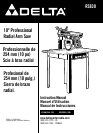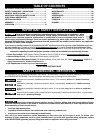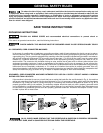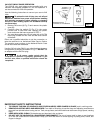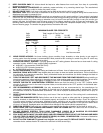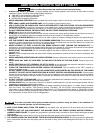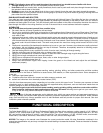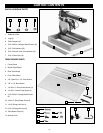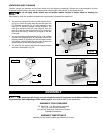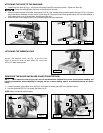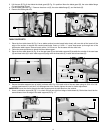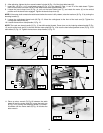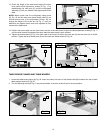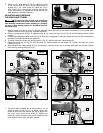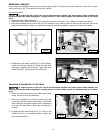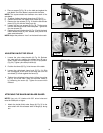
7
Some dust created by power sanding, sawing, grinding, drilling, and other construction activities contains
chemicals know to the State of California to cause cancer, birth defects, or other reproductive harm. Some examples of
these are:
l Lead from Lead-based paints,
l Crystalline silica from bricks and cement and other masonry products, and
l arsenic and chromium from chemically-treated lumber (CCA).
Your risk from these exposures varies, depending on how often you do this type of work. To reduce your exposure to these
chemicals: work in a well-ventilated area, and work with approved safety equipment, such as those dust masks that are
specially designed to filter out microscopic particles.
l Avoid prolonged contact with dust from power sanding, sawing, grinding, drilling, and other construction activities.
Wear protective clothing and wash exposed areas with soap and water. Allowing dust to get into your mouth, eyes,
or lay on the skin may promote absorption of harmful chemicals.
Use of this tool can generate and/or disburse dust, which may cause serious and permanent respiratory or
other injury. Always use NIOSH/OSHA approved respiratory protection appropriate for the dust exposure. Direct particles
away from face and body. Always operated tool in a well-ventilated area and provide for proper dust removal. Use dust
collection system wherever possible.
FOREWORD
FUNCTIONAL DESCRIPTION
NOTICE: The image on the manual cover illustrates the current production model. All other illustrations contained in the
manual are representative only and may not depict the actual labeling or accessories included. These are intended to illustrate
technique only.
The Delta Model RS830 is a 10" (254mm) Professional Radial Arm Saw with a maximum cutting capacity of 16" (406mm)
crosscut, 2-3/4" (70mm) depth at 90°, and 2-1/2" (64mm) depth at 45° bevel. This tool has positive bevel stops at 0°, 45° and
90°, and positive miter stops at 0° and 45°, both right and left. The unit includes a 1-1/2 HP, 120/240V motor, an automatic
blade brake, a saw blade, wrenches, a steel stand, a cast-iron track, and an extra-large table.
SAW BLADE GUARD AND SPLITTER
Your radial arm saw is equipped with a blade guard, splitter and anti-kickback fingers. The splitter fits into the cut made by
the saw blade when ripping and effectively fights kickback by lessening the tendency of the blade to bind in the cut. Use the
spreader and blade guard for all cuts. Two anti-kickback pawls are located on the sides of the splitter that allow the wood to
pass through the blade in the cutting direction, but lock if the wood tries to move backward toward the operator.
KICKBACKS
How to avoid them and protect yourself from possible injury.
a. Be certain that the rip fence is parallel to the saw blade.
b. Do not rip by applying the feed force to the section of the workpiece that will become the cut-off (free) piece. Feed force
when ripping should always be applied between the saw blade and the fence. Use a push stick for short work, 6" (152
mm) wide or less.
c. Keep saw blade guard, splitter, and anti-kickback teeth in place and operating properly. Keep teeth sharp. If teeth are not
operational, return your unit to the nearest authorized Delta service center for repair. The splitter must be in alignment
with the saw blade and the teeth must stop a kickback once it has started. Check their action before ripping by pushing
the wood under the anti-kickback teeth. The teeth must prevent the wood from being pulled toward the front of the
saw.
d. Plastic and composition (like hardboard) materials may be cut on your saw. However, since these are usually quite hard
and slippery, the anti-kickback pawls may not stop a kickback. Therefore, be especially attentive to following proper
set-up and cutting procedures for ripping.
e. Use saw blade guard for every operation for which it can be used, including all through-sawing.
f. Push the workpiece past the saw blade prior to release when ripping.
g. NEVER rip a workpiece that is twisted or warped, or does not have a straight edge to guid along the fence.
h. NEVER saw a large workpiece that cannot be controlled.
i. NEVER saw a workpiece with loose knots, flaws, nails, or other foreign objects.
j. NEVER rip a workpiece shorter than 10".
k. Always use anti-kickback fingers when ripping. Lower the guard on the infeed end and adjust the anti-kickback
attachment properly.
TERMS: The following terms will be used throughout the manual and you should become familiar with them.
• Through-sawing refers to any cut that completely severs the work piece.
• Push Stick refers to a wooden stick, usually homemade, that is used to push small work piece through the saw and keeps
the operator’s hands clear of the blade.
• Kickback occurs when the saw blade binds in the cut and violently thrusts the work piece back toward the operator.
• Freehand refers to cutting without the use of a miter gauge or rip fence or any other means of guiding or holding the work
piece other than the operator’s hand.



